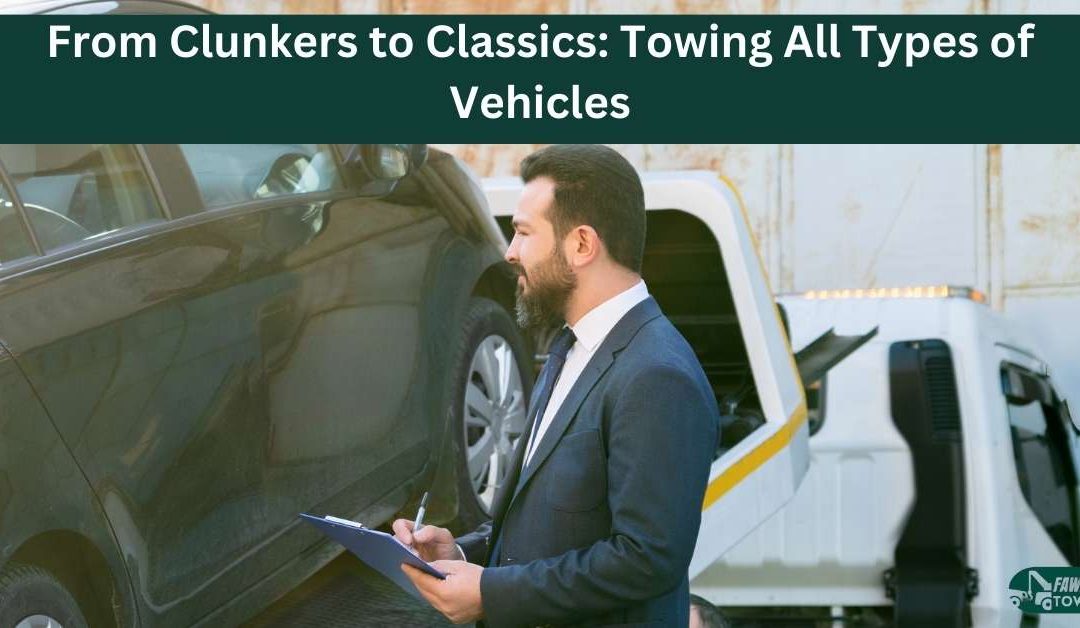Whether you’re rescuing a vintage classic or towing an aging clunker to the scrapyard, handling a diverse range of vehicles requires expertise and caution. Towing is not a one-size-fits-all endeavor, and understanding the nuances of different vehicles is crucial for a successful and damage-free operation. In this article, we’ll explore the art of towing, from clunkers to classics, and provide essential tips to ensure a smooth and secure towing experience.
Assessing the Weight and Size:
Before towing any vehicle, it’s vital to know its weight and dimensions. Different vehicles come with varying towing challenges, from compact cars to oversized trucks. Consult the manufacturer’s specifications or use a reliable scale to determine the weight of the vehicle and trailer combined. This information is essential for selecting the right towing equipment and ensuring your vehicle is up to the task.
Choose the Right Towing Equipment:
Towing capabilities vary among vehicles, and having the appropriate equipment is paramount. Invest in a towing hitch that matches your vehicle’s towing capacity, and use the right type of trailer for the job. Depending on the size and weight of the vehicle, you may need specialty equipment such as tow dollies or flatbed trailers. Matching your towing gear to the specific needs of each vehicle guarantees a safer and more effective towing operation.
Secure the Vehicle Properly:
Properly securing the vehicle to the trailer is essential to prevent damage and ensure stability during transit. Use high-quality straps and tie-downs to secure the vehicle in place. Pay special attention to the vehicle’s suspension and steering components to avoid unnecessary strain. Classics, in particular, may require extra care to protect their pristine condition during transportation.
Consider Specialized Towing Techniques:
Certain vehicles, like classics or low-suspension sports cars, require specialized towing techniques. For low-clearance vehicles, consider using a flatbed trailer to eliminate the risk of scraping the undercarriage. Be mindful of classic cars with sensitive components and opt for soft straps or wheel nets to secure them without causing damage. Understanding the unique requirements of each vehicle type ensures a tailored and safe towing approach.
Check and Adjust Trailer Load Distribution:
Maintaining proper load distribution on the trailer is critical for towing stability. Pay attention to the weight distribution of the towed vehicle to prevent swaying and control issues. Adjust the load as needed to ensure an even distribution across the trailer axles. This is particularly important when towing larger vehicles, as improper weight distribution can lead to handling difficulties.
Drive with Extra Caution:
The handling characteristics of your towing setup will vary depending on the towed vehicle. Exercise extra caution, especially when towing high-profile vehicles or classics with unique handling traits. Adjust your driving speed based on the specific challenges posed by the towed vehicle, and be mindful of braking distances and turning radius.
Conclusion:
From clunkers to classics, towing a variety of vehicles demands versatility and expertise. By assessing the weight and size of each vehicle, choosing the right towing equipment, securing the vehicle properly, employing specialized towing techniques, checking load distribution, and driving with extra caution, you can navigate the towing landscape with confidence. With the right knowledge and equipment, you’ll be prepared to tow any vehicle, ensuring a successful and damage-free transport. Safe towing!
If you are in Kyneton, Victoria 3444, and looking for a tow truck service, below is the best way to visit us.
Fawkner Towing
18 Emma St, Fawkner VIC 3060
(03) 4050 4989


Recent Comments